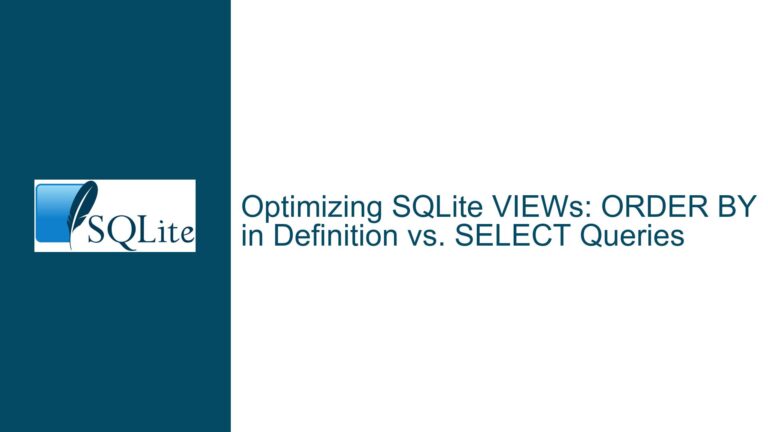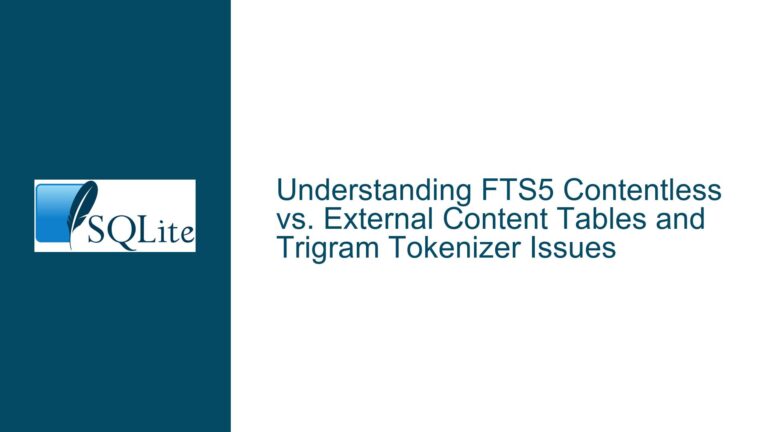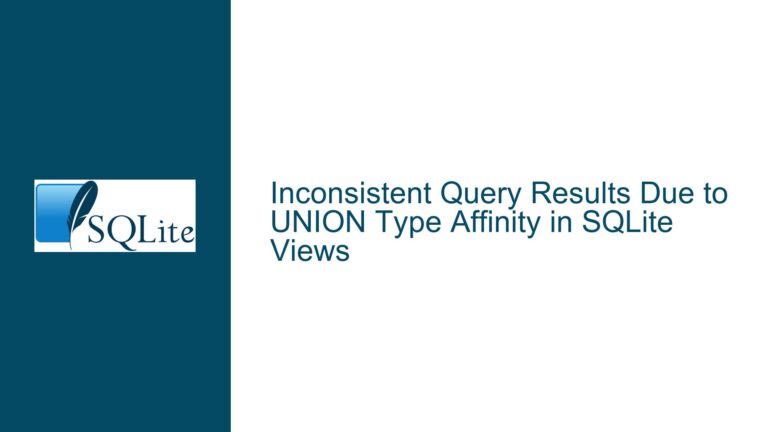Segfaults in SQLite LATERAL Joins with Coroutine Interactions
Segfaults and Parse Errors in LATERAL Joins with Aggregate Functions and Coroutine References
Issue Overview
The core problem revolves around SQLite’s experimental LATERAL join implementation interacting unpredictably with two features:
- Aggregate/window functions in the LATERAL subquery when referencing columns from outer tables.
- Coroutine optimizations (specifically the "VALUES-as-coroutine" feature introduced in SQLite 3.46.0).
Queries that combine these elements may trigger segmentation faults or parse errors, depending on the structure of the LATERAL subquery and the way outer columns are referenced.
Key Failure Scenarios:
Segfaults from Aggregate Functions in LATERAL with Multi-Row Outer Tables
When a LATERAL subquery uses an aggregate function (e.g.,COUNT(*)) and references a column from an outer table that produces multiple rows, SQLite crashes.
Example:-- Segfaults: outer VALUES has 2 rows, LATERAL references outer column1 SELECT * FROM (VALUES (1), (2)) JOIN LATERAL (SELECT COUNT(*), column1);Why This Fails:
The LATERAL subquery attempts to referencecolumn1from the outerVALUESclause, which is implemented as a coroutine. The coroutine optimization precomputes theVALUESbefore the parser processes the LATERAL join, leading to a mismatch in how column references are resolved.Parse Errors in LATERAL Subqueries with Dynamic LIMIT Clauses
Referencing outer columns in aLIMITclause within a LATERAL subquery produces a "no such column" error, even when the column exists.
Example:-- Parse error: column1 not recognized in LIMIT SELECT * FROM (VALUES (1)) JOIN LATERAL (SELECT 1 LIMIT column1);Why This Fails:
TheLIMITclause’s expression resolution occurs in a scope where outer table columns are not yet accessible. This is a parser limitation exacerbated by the LATERAL join’s interaction with the outer query’s execution phases.Covering Index Column Reference Failures
When a LATERAL subquery references a column from a covering index (not the base table), SQLite may fail to resolve the column if the base table is unopened.
Example:-- Fails to resolve column "d" from covering index t2cd SELECT c, a, sb FROM t2 JOIN LATERAL (SELECT a, SUM(b) AS sb FROM t1 ... HAVING sb < d);Why This Fails:
The query planner uses a covering index (t2cd) fort2, so the base tablet2is not opened. The LATERAL subquery expects to read columndfrom the base table, not the index, causing a resolution failure.
Underlying Causes of LATERAL Join Failures
Coroutine Optimization Preemption
The "VALUES-as-coroutine" optimization (SQLite 3.46.0+) precomputesVALUESclauses as independent coroutines. When a LATERAL join references columns from such a coroutine:- The coroutine’s columns are not made available to the LATERAL subquery’s resolution scope.
- The parser assumes all outer tables are materialized (e.g., actual tables or materialized subqueries), not coroutines.
Technical Breakdown:
Coroutines in SQLite are implemented as generators that yield rows on demand. When a LATERAL subquery references a coroutine column:- The coroutine’s execution context is not shared with the LATERAL subquery’s executor.
- This leads to dangling pointers or invalid memory access (segfaults) when the LATERAL subquery attempts to read from the coroutine’s uninitialized or deallocated context.
Scope Resolution Order in the Parser
SQLite’s parser resolves column references in a strict left-to-right, outer-to-inner order. However:- The
LIMITclause is parsed before the rest of the LATERAL subquery’s FROM clause. - Outer columns referenced in
LIMITare not yet in scope, causing parse errors.
- The
Covering Index Column Visibility
When a covering index is used:- The base table is not opened, but its columns are still expected to be resolvable.
- The LATERAL subquery’s column resolution logic does not account for index-only scans, assuming base table access.
Resolving Segfaults, Parse Errors, and Column Reference Issues
Step 1: Identify Coroutine-LATERAL Interactions
Check for:
VALUESclauses or subqueries in the FROM clause to the left of a LATERAL join.- Aggregate/window functions in the LATERAL subquery referencing outer columns.
Temporary Workaround:
Materialize the outer query’s result using a CTE or temporary table:
WITH OuterTable AS (SELECT * FROM (VALUES (1), (2)))
SELECT * FROM OuterTable JOIN LATERAL (SELECT COUNT(*), column1);
This forces the outer query to be materialized, bypassing coroutine optimizations.
Step 2: Rewrite Queries with Dynamic LIMIT Clauses
Avoid referencing outer columns directly in LIMIT. Use a subquery:
SELECT * FROM (VALUES (1)) AS v1
JOIN LATERAL (
SELECT 1 LIMIT (SELECT column1 FROM v1)
);
Why This Works:
The subquery in LIMIT has access to outer scope columns, whereas literal references do not.
Step 3: Force Base Table Access for Covering Indexes
Add a dummy condition to force the query planner to open the base table:
SELECT c, a, sb FROM t2
JOIN LATERAL (SELECT ... HAVING sb < d OR t2.rowid IS NOT NULL);
Why This Works:
Referencing t2.rowid forces the query planner to open the base table, making all columns (including those in covering indexes) resolvable.
Step 4: Apply Patches from the Lateral-Join Branch
The lateral-join branch (as of check-in 31e175fcd0ff8239) fixes:
- Coroutine-LATERAL interactions.
- Covering index column resolution.
Compiling the Fix:
- Download the branch:
wget https://sqlite.org/src/tarball/lateral-join/sqlite-lateral-join.tar.gz tar xzf sqlite-lateral-join.tar.gz cd sqlite-lateral-join - Compile with debugging symbols:
./configure --enable-debug make - Test the failing query:
SELECT * FROM (VALUES (1), (2)) JOIN LATERAL (SELECT COUNT(*), column1);
Step 5: Use LATERAL Joins for Practical Use Cases
To justify merging LATERAL into SQLite’s trunk, demonstrate its utility:
Use Case 1: Deduplicating Complex Calculations
Without LATERAL:
SELECT
width * height * depth AS volume,
(width * height * depth) * 0.5 AS shipping_weight
FROM items;
With LATERAL:
SELECT volume, volume * 0.5 AS shipping_weight
FROM items
JOIN LATERAL (SELECT width * height * depth AS volume);
Use Case 2: Top-N Per Group Queries
Without LATERAL:
SELECT user_id, title, rating
FROM (
SELECT
user_id,
title,
rating,
ROW_NUMBER() OVER (PARTITION BY user_id ORDER BY rating DESC) AS rn
FROM movies
) WHERE rn <= 3;
With LATERAL:
SELECT m.user_id, l.title, l.rating
FROM users m
JOIN LATERAL (
SELECT title, rating
FROM movies
WHERE user_id = m.user_id
ORDER BY rating DESC
LIMIT 3
) l;
Use Case 3: Recursive CTE Column Dependencies
Without LATERAL:
WITH RECURSIVE series(id, a, b) AS (
SELECT 1, 10, 10 * 2
UNION ALL
SELECT
id + 1,
prev.b + 5,
(prev.b + 5) * 2 -- Repeated calculation
FROM series prev
)
SELECT * FROM series;
With LATERAL:
WITH RECURSIVE series(id, a, b) AS (
SELECT 1, 10, 10 * 2
UNION ALL
SELECT
id + 1,
l.a,
l.a * 2
FROM series prev
JOIN LATERAL (SELECT prev.b + 5 AS a) l
)
SELECT * FROM series;
Step 6: Validate PostgreSQL Compatibility
Test SQLite’s LATERAL implementation against PostgreSQL’s:
-- PostgreSQL and SQLite (with lateral-join branch):
SELECT * FROM (VALUES (1), (2)) v1
JOIN LATERAL (SELECT v1.column1 * 2);
Known Differences:
- PostgreSQL allows
LATERALbefore table-valued functions (no-op). SQLite rejects this. - SQLite requires explicit
LATERALfor subqueries referencing outer columns; PostgreSQL infers it.
Final Recommendation:
LATERAL joins resolve real-world problems like calculation deduplication, top-N queries, and recursive CTE simplification. While workarounds exist, LATERAL provides cleaner, more maintainable SQL. Merging the lateral-join branch into trunk is justified for users requiring advanced query patterns and cross-database compatibility.






